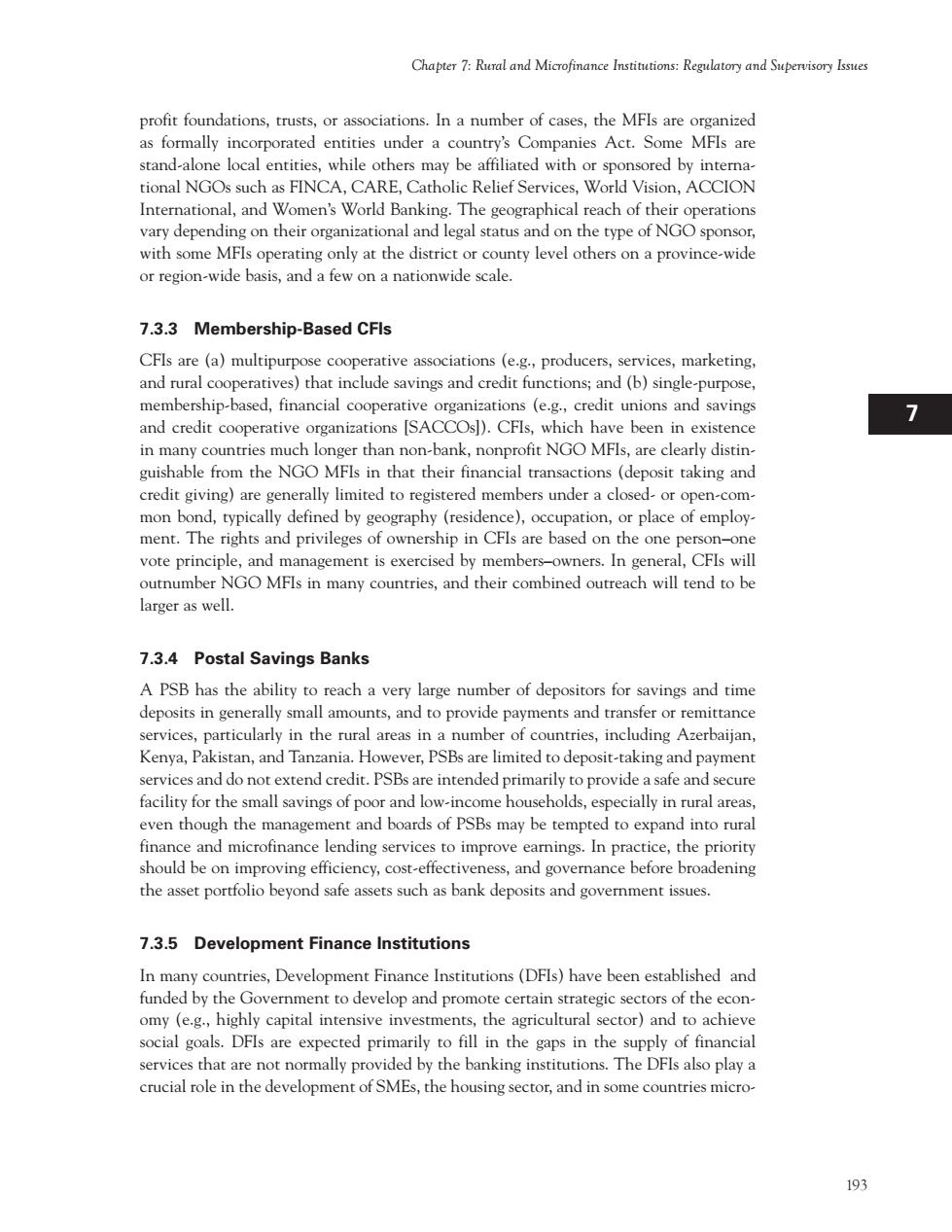正在加载图片...

Chapter 7:Rural and Microfinance Instittions:Regulatory and Supervisory Issues 心n nies Act.Some MFIs are stand others may be affiliated with or sponsored by intema tional NGOs such as FINCA,CARE,Catholic Relief Services,World Vision,ACCION International,and Women's World Banking.The geographical reach of their operations vary depending on their organizational and legal status and on the type of NGO sponsor with some MFIs operating only at the district or county level others on a province-wide or region-wide basis,and a few on a nationwide scale. 7.3.3 Membership-Based CFls associations (e.g.,producers,services,marketing and rura savings and credit functions;and (b)singl membership-based,financial cooperative organi ns (e.g credit unions and savings and credit cooperative organizations [SACCOs]).CFls,which have been in existence in many countries much longer than non-bank,nonprofit NGO MFls,are clearly distin. guishable from the NGO MFIs in that their financial transactions (deposit taking and credit giving)are generally limited to registered members under a closed-or open-com- mon bond typically defined by geography (residence),occupation,or place of employ ts and pri vileg in CFls a and m ment is exercised b owners.In gene I CFIs wil umber MFin many countreand their sombned outrechill tend to b member larger as well 7.3.4 Postal Savings Banks A PSB has the ability to reach a very large number of depositors for savings and time deposits in generally small amounts,and to provide payments and transfer or remittance services,particularly in the rural areas in a number of countries,including Azerbaijan Kenya,Pakistan,and Tanzania.However,PSBs are limited to deposit-taking and payment es and do nd credit PSBs e intended primari ovide a safe and se mall savings of poo r and I eholds,especially in rural area even though the management and boards of PSBs may be tempted to expand into rura finance and microfinance lending services to improve earnings.In practice,the priority should be on improving efficiency,cost-effectiveness,and governance before broadening the asset portfolio beyond safe assets such as bank deposits and government issues. 7.3.5 Development Finance Institutions In many countries,Development Finance Institutions (DFIs)have been established and pital ine cted prim the gaps in the of fin a services t at are not normally provided by the banking institutions.The DFIs also play a crucial role in the development of SMEs,the housing sector,and in some countries micro 193 Chapter 7: Rural and Microfinance Institutions: Regulatory and Supervisory Issues 1 I H G F E D C B A 12 11 10 9 8 7 6 5 4 3 2 profit foundations, trusts, or associations. In a number of cases, the MFIs are organized as formally incorporated entities under a country’s Companies Act. Some MFIs are stand-alone local entities, while others may be affiliated with or sponsored by international NGOs such as FINCA, CARE, Catholic Relief Services, World Vision, ACCION International, and Women’s World Banking. The geographical reach of their operations vary depending on their organizational and legal status and on the type of NGO sponsor, with some MFIs operating only at the district or county level others on a province-wide or region-wide basis, and a few on a nationwide scale. 7.3.3 Membership-Based CFIs CFIs are (a) multipurpose cooperative associations (e.g., producers, services, marketing, and rural cooperatives) that include savings and credit functions; and (b) single-purpose, membership-based, financial cooperative organizations (e.g., credit unions and savings and credit cooperative organizations [SACCOs]). CFIs, which have been in existence in many countries much longer than non-bank, nonprofit NGO MFIs, are clearly distinguishable from the NGO MFIs in that their financial transactions (deposit taking and credit giving) are generally limited to registered members under a closed- or open-common bond, typically defined by geography (residence), occupation, or place of employment. The rights and privileges of ownership in CFIs are based on the one person–one vote principle, and management is exercised by members–owners. In general, CFIs will outnumber NGO MFIs in many countries, and their combined outreach will tend to be larger as well. 7.3.4 Postal Savings Banks A PSB has the ability to reach a very large number of depositors for savings and time deposits in generally small amounts, and to provide payments and transfer or remittance services, particularly in the rural areas in a number of countries, including Azerbaijan, Kenya, Pakistan, and Tanzania. However, PSBs are limited to deposit-taking and payment services and do not extend credit. PSBs are intended primarily to provide a safe and secure facility for the small savings of poor and low-income households, especially in rural areas, even though the management and boards of PSBs may be tempted to expand into rural finance and microfinance lending services to improve earnings. In practice, the priority should be on improving efficiency, cost-effectiveness, and governance before broadening the asset portfolio beyond safe assets such as bank deposits and government issues. 7.3.5 Development Finance Institutions In many countries, Development Finance Institutions (DFIs) have been established and funded by the Government to develop and promote certain strategic sectors of the economy (e.g., highly capital intensive investments, the agricultural sector) and to achieve social goals. DFIs are expected primarily to fill in the gaps in the supply of financial services that are not normally provided by the banking institutions. The DFIs also play a crucial role in the development of SMEs, the housing sector, and in some countries micro-